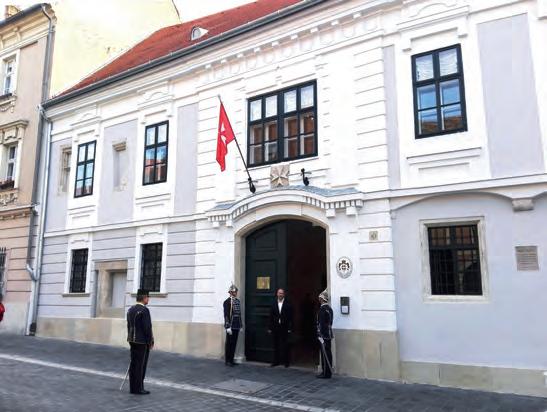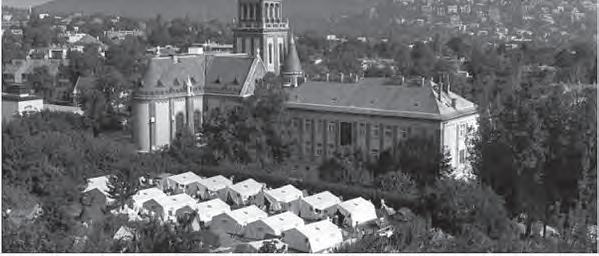
7 minute read
HUNGARY The Order of Malta in
By Barbara Piazza-Georgi
A unique set of circumstances and characters converged 30 years ago in Hungary, to create one of the largest operations of the Order of Malta in the world. It did not come out of the blue: it marked the worthy return of a prestigious actor in Hungary’s early history.
The early history of the Order in Hungary begins almost as early as that of the Order itself: the first record dates to 1138. Hungary was a border area of Christianity, still at war with pagans; also, it was on the land route to the Holy Land. So, few Hungarian knights went to the Holy Land: they worked at home, taking care of passing pilgrims, tending to the sick and fighting against local pagan threats. At the same time, they helped finance operations in the Holy Land. King Andrew II himself went on the Fifth Crusade and donated generously to the Hospitaller castles of Margat and Krak des Chevaliers, for which he was made a Donat of the Order.
There were dozens of hospitals, convents, and churches of the Order of Saint John in medieval Hungary. They also helped with law enforcement and functioned as notaries public. During the Mongol invasion of 1241 they fought alongside the King, who escaped thanks to the Knights, and survived to return and rebuild the country.
The Hungarian knights fought bravely but hopelessly against the invading Turks. By the 16th Century, as Hungary was partitioned between the Turks and the Austrian emperors, the autonomy of the Order in Hungary ceased. Surviving knights were merged into the German “langue” and into the Austrian Grand Priory.
Birth of the Association
All changed with the split-up of the AustroHungarian empire at the end of World War I. In 1925, diplomatic relations were established between the Order and Hungary. In 1928, the Association of the Hungarian Knights of Malta (MMLSZ) was created, with 40 members who transferred from the Austrian and Bohemian units. In 1933, MMLSZ bought its current house in Buda Castle and began to establish its Hospitaller activities.

But then came the catastrophe of World War II and the Communist takeover. MMLSZ was banned, and its severely damaged house was nationalised. Most of the Knights fled to the West; those who stayed were branded “enemies of the people”. Several disappeared or died in prison, most were deported to remote areas of the country.
Yet MMLSZ reorganised itself in 1953 “in exile”, with seat in Rome, gathering – in a long-distance relationship – those dozens of members who had fled to the West. It supported refugees of the 1956 revolution, especially for their further education; but its long-term focus was on sending relief packages to individuals in Hungary, mostly to those whose social class caused them to be persecuted as “enemies of the people”. In 1966, it created a literary award to encourage émigré Hungarian writers.


Return, and the blossoming of the Charity Service
By the late 1980s, the Order could appear more openly in Hungary. In 1987-1988, MMLSZ sent 28 truckloads of medical and humanitarian goods – collected by members living in France and Germany – to the Hungarian Catholic Church, with the approval of the Communist government. This is where Father Imre Kozma, a young dynamic parish Priest in Budapest, and his team of young volunteers, entered the picture. They were tasked to help with distribution. Then Csilla von Boeselager, a Dame of the Order living in Germany, joined the operation: she and Father Kozma became its leaders. In February 1989, the Hungarian Charity Service of the Order of Malta was legally registered. It was still only about distributing truckloads of donations secured through MMLSZ (mostly Csilla herself) in the West; but almost immediately, the German refugee crisis of summer 1989 exposed the young organisation to an extraordinary, also politically dangerous, challenge, which it met brilliantly and with much media exposure. Then came the Romanian revolution of December 1989 and the Yugoslav war two years later, which Father Kozma and his young team faced with the expertise and confidence inspired by their recent success. These successful humanitarian interventions established the Charity Service as the

Clockwise from opposite page: Apor Vilmos statue in Budapest; East German refugees in a camp on parish grounds in 1989; Ambulance service funded by the Order; The house of the Order in ruins in 1945; The house of the Order restored in Buda Castle today; Historical photo of Bishop Apor with children.
BLESSED VILMOS APOR, BISHOP AND MARTYR
On 2 April 1945, the much-loved Bishop of Győr (pictured opposite page, with children), in western Hungary, was fatally shot by a group of drunken soldiers of the invading Red Army. Many women and girls had taken refuge in the episcopal palace: the marauding group had discovered them and wanted to drag them away. The Bishop stood in their way and tried to reason with them, but one youth let loose a deadly volley from his machinegun.

The sight of the unarmed, brave prelate collapsing in blood frightened the drunken youths, who slunk out without harming the women. The Bishop lived long enough to be told this. He whispered with a smile: “It was worth it then!”
Bishop Vilmos (William) Apor had been ordained in 1914. He was deeply committed to social issues, especially the protection of women, poor children, and religious education. He was known as “the parish priest of the poor”. He supported Catholic renewal movements.
The scion of one of Transylvania’s historical Hungarian families, he joined the Order of Malta in 1937 as Conventual Chaplain Ad honorem.
When he was consecrated Bishop in 1940, his brother Gábor Apor – who later became Grand Chancellor of the Order of Malta –stood the expenses of the celebration, while the new Bishop celebrated by paying the accumulated debts of a local orphanage. As a Bishop, he took political stands too. In 1944, he condemned the persecution of the Jews: “Whoever betrays the fundamental principle of Christianity, that of love… and proclaims that it is lawful to torment human beings, be they Blacks, or Jews… as much as he may boast about his Christianity, he is like a pagan or a public sinner.” He wrote to the Fascist Minister of the Interior, to the Regent and to the Cardinal Primate, protesting the deportations.
On 7 July 1997, Pope John Paul II granted him the title of Martyr. He was beatified on 9 November 1997.
Let us pray that Blessed Vilmos Apor may one day become one of the Saints of the Order!
In 1990 the Order established diplomatic relations with the new postCommunist Republic of Hungary. It recovered its house, which underwent extensive repairs and refurbishing. On 27 January, 1996, the seat of MMLSZ officially returned to Buda.
And the Charity Service grew. Father Kozma and his team, imbued with the spirit of Christian social activism – unusual for the society of that time, which was still steeped in a Socialist mentality of passiveness and “passing the buck” to the state – started a service to the homeless, assistance to the disabled, emergency and ambulance units, and other social services. The Charity Service quickly established branches in the whole country, attracting hundreds of like-minded people who were coming out of the woodwork in these early post-Communist times. It gradually became a privileged partner of the government, which recently transferred several Staterun schools and social institutions to its management, recruited it as an implementing partner for the Hungarian bilateral aid program abroad, and entrusted it with the national program for the integration of the poorest settlements (see box opposite page).


In 2021, the Charity Service had an annual budget in the order of US$70 Million, of which about half were Government subsidies, 20 per cent project grants and 20 per cent beneficiaries’ contributions. Out of this budget, it operates – mostly through salaried staff – 24 retirement homes, 57 homeless shelters of various kinds, 15 schools, 38 institutions for the disabled, 11 service points for addicts, 6 family shelters, 51 child-oriented services, 12 health centres or services, as well as soup kitchens, home care services, mobile services, and an ambulance service. On an average day, the Hungarian Charity Service of the Order of Malta serves over 22,000 people. It also runs humanitarian programs in Africa and the Middle East on behalf of the Hungarian government. It is currently running a large program of support to Ukrainian refugees and aid to Ukraine.

As for MMLSZ, today it has about 160 members: fewer and fewer live abroad, as the old émigré Hungarians die out, or return to spend their last years in Hungary. MMLSZ is thus returning to the normal set-up of a National Association of the Order, enhanced by an exceptionally strong and largely independent “auxiliary” service, and enjoying a privileged relationship with the national government. The Order’s house was recently beautifully enlarged and renovated, thanks to a government grant. In addition to the work of the Charity Service, MMLSZ members organise the annual Lourdes pilgrimage, operate a lending service for home care equipment, organise a biannual charity ball to finance participation in the Order’s international summer camps for the disabled, and help Hungarian-speaking communities in Slovakia and Ukraine, often together with the Hungarian branch of the Johanniter Order. Since 2017, MMLSZ has organised an annual public scientific conference in Budapest, on subjects relevant to Christian life and ethics.
The Presence Program
The Hungarian Charity Service runs one of the largest and most successful social integration programs for disadvantaged (mostly Gypsy) communities in Europe. It started 20 years ago, when a Confrère who worked full-time for the Charity Service, one of Father Imre Kozma’s original team and an experienced social worker, started a project in one of the poorest settlements of Hungary, based on two principles: full-time presence by the project team, and tailored interventions in all priority areas, based on specific local needs and requests. This approach, called integrated local development, is well-known in development theory as a best practice, but rarely used, because it is too long-term for most financing modalities, and because it needs serious funding, expertise, and committed, loving staff of the kind that is not easy to find in bureaucracies or development agencies. The project, in this case, included among others an after-school remedial program, a health clinic, a mother-and-baby club, setting up small local enterprises (notably a workshop for dismantling and recycling electronic waste), and ombudsman services.
This first pilot initiative became – after many years of struggle! – a success story: the village is now served by local entities and the private sector, with some interesting innovative activities. The project went on to other settlements, with new ideas: a mobile playground, teaching music, football, small enterprises for women, a carpentry workshop and training centre…. A few failures, but many successes: enough to secure financing by the European Union, which tried to spread the model to other countries of the sub-region. Eventually, the Hungarian government adopted it as its national strategy for the 300 poorest settlements of the country.
Our Confrère, Miklós Vecsei, became State Commissioner for overseeing this program, which still executed by the Charity Service, but now with a dozen other Hungarian faith-based NGOs as its subcontractors, and serious Government and EU funding.
The full-scale project covering 300 villages has only been running for a couple of years, but “watch this space” for possibly one of the great success stories of the Order of Malta in our era!











